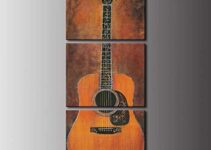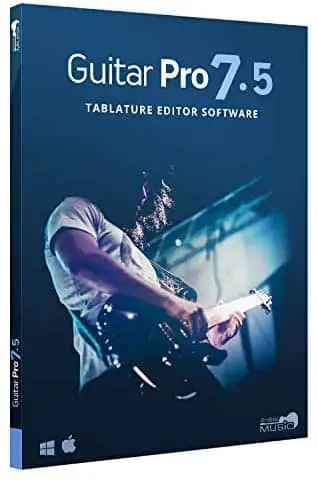
Plini hails from Sydney, Australia and is at the forefront of the newest generation of guitar heroes. As well as a host of EP releases, Plini has two albums to date: Handmade Cities from 2016 and 2020’s Impulse Voices.
Plini cites Joe Satriani as an influence, which is evident from his melodic and vocal style of playing. The music also has a foot in progressive metal, with heavy riffs and syncopated rhythms. Songs like Electric Sunrise, Inhale and Pan are akin to Animals As Leaders and Periphery, but with very much their own Plini flavour.
Plini is known for playing his Strandberg signature guitars, typically in Drop C# tuning (C#-G#-C#-F#-A#-D#), but for your convenience we have recorded these examples in dropped D (D-A-D-G-B-E).
Our first example features picking-hand tapping, coupled with arpeggios in the fretting-hand. This one is based in A Lydian, but the concept can be applied to any key or mode. The four arpeggios are arranged with the 7th and root on the second string and the 3rd and 5th on the first.
You can adjust any of these intervals to make major, minor, augmented or diminished 7th shapes. Use these to outline the chords in the key or mode you are in and use your tapping finger to repeat any notes of your choosing.
The phrasing here moves across the beat in an interesting way, with a three-note melodic shape, played through 16ths. This might be confusing at first, but after practising slowly it should soon feel comfortable.
Example 2 is an odd-time prog riff utilising fretting-hand tapping – essentially the same as hammering on a note. You don’t need a lot of force, just enough to sound the note.
The most important aspect is stopping the other strings from ringing in sympathy, so use your first fretting-hand finger in a light barring position and the side of your picking palm to mute unused strings; with practice, you should be able to cleanly sound just one note at a time using just your fretting fingers.
Plini’s melodic side features a lyrical, vocal style phrasing using mainly pentatonic and diatonic notes. One way of adding a classier note choice is by superimposing pentatonics.
Example 3 demonstrates an accessible way into this concept for minor keys. When playing in A minor, our natural choice is to play A minor pentatonic (A-C-D-E-G), but you can also think from the 5th note in the key, which is E.
E minor pentatonic (E-G-A-B-D) contains only notes that belong to the key of A minor, but this slight change of perception invokes a more fusion sound. Example 4 ups the fusion ante with some jazzy chromatic passing notes.
The concept here is to use the scale as a framework, in this case the Dorian mode, but it will work just as well with other modes, like Mixolydian, or Lydian and so on. Focus on the scale notes, but fill in the blanks in-between the notes with chromatics in order to create tension, then land on a scale tone to resolve.
Our final example is an alternate-picked unison part. Unisons need to be executed perfectly in time and alternate picking helps, although moving the pick from string to string can be tricky without the correct pick angle. Be sure to keep the tip of the pick tilted slightly upward, so the up strokes will clear the next thicker string. This makes for cleaner string-to-string moves, and more confident down strokes, too.
Get the tone
Amp settings: Gain 3, Bass 7, Middle 6, Treble 7, Reverb 2
Plini switches pickups and sounds all the time, going from a clean neck pickup tone to a raunchy bridge humbucker, through to full-on Satch Boogie mode. Start with a warm, clean neck pickup tone, and for extra gain jump on your overdrive pedal or boost, and onto a big but still smooth distortion if you have the means. Try some long delay and lots of reverb, too.
Example 1. Tapped lydian lick with arpeggios
For this A Lydian lick, use the first or second finger of your picking hand to tap the 12th-fret notes, then use your fretting hand to spell out the lower four notes (two notes per string). Although the melody is a repeating three-note phrase, be sure to play 16th notes, not triplets which increases a listener’s interest.
Example 2. Using fretting and picking-hand taps
Play the squared notes with fretting-hand tapping, which means hammering on those notes, while simultaneously preventing any open-string noise with fretting-hand muting. Once you can play the fretting-hand notes cleanly, add the picking-hand taps to complete the riff.
Example 3. Superimposing pentatonics
Although the backing track is in A minor, you can visualise this lick as being E minor pentatonic based. Use hammer-ons and slides to move through the positions from 5th to 12th fret, then play sus4 arpeggio shapes on the treble strings, finishing with a melodic tone bend and vibrato.
Example 4. Dorian lick with passing notes
This 120bpm lick is based in D Dorian (D-E-F-G-A-B-C) but with some added chromatic passing tones. After the initial scale-based phrase, use two-notes-per-string Cmaj7 shapes to climb up to the first string before descending with chromaticism and A minor pentatonic.
Example 5. E minor pentatonic unison lick
The guitar here plays in unison with the other instruments on the backing track. All of the notes are E minor pentatonic (E-G-A-B-D) played in a two-notes-per-string style employing alternate picking. Use the very tip of your pick to lightly play each pair of notes with a down and an up stroke.
Thank you for reading 5 articles this month*
Join now for unlimited access
US pricing $3.99 per month or $39.00 per year
UK pricing £2.99 per month or £29.00 per year
Europe pricing €3.49 per month or €34.00 per year
*Read 5 free articles per month without a subscription
Join now for unlimited access
Prices from £2.99/$3.99/€3.49



